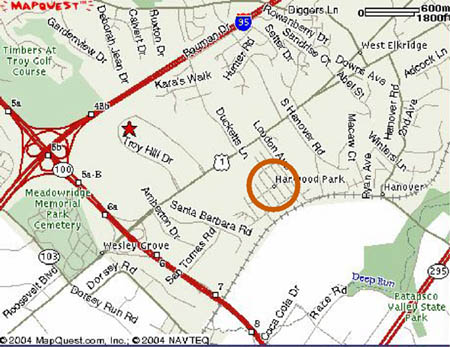Howard County Arboreta: Harwood Park (original) (raw)
Arboreta Links:
- Wilde Lake
- Jackson Pond
- Howard County Office Complex
- Guilford Park
- Centennial Park
- Harwood Park
- Lake Elkhorn
- Howard Community College
- Robinson Nature Center
Arboreta Homepage
Forestry Homepage

In cooperation with the Howard County Department of Recreation and Parks, the Forestry Board formally opened the Harwood Park Arboretum. On Thursday, 7 April 2004, a bright and sunny morning, a goodly crowd gathered to witness the opening of the Arboretum, and to take part in the ceremonies.
History
Harwood Park is a neighborhood in a Howard County suburb, located in Elkridge, Maryland. Harwood Park is Howard County�s first planned community. Its unique feature is the varied age and beauty of different architectural housing styles and mature foliage throughout the neighborhood.
Before 1893, the neighborhood you see today was farmland. Thomas Cottingham is the first documented landowner in this area; later the land was purchased by William Kyne. The Kyne family farmed most of the 125 acres known as "Harwood Park." Although the farmland has long since vanished, the Kyne�s original farmhouse remains today, at the corner of Highland and Euclid Avenues.
The land for the community was later purchased and developed by the Boston Land Improvement Company. On July 24, 1893, the new community of "Har-wood" was created. The development derived its name after two of the owners, William E. Harman and Charles Wood, of the Boston Land Improvement Company.
The Harwood Neighborhood Park dates back to 1977 when the Elkridge Advisory Committee first requested the construction of a neighborhood park. On September 15, 1982, funded through county capital project funds and a HUD community development block grant, the "Harwood Neighborhood Park" was officially open to the public. The original park included a full basketball court, tot lot and swings, similar to the park you see today.
Trees at Harwood Park
In addition to providing recreational opportunities, Harwood Park has a fine collection of trees and shrubs. Each tree below is linked to itsArborTagwhich describes the distinguishing features of the species. Those pages can be used to make your own laminated tree tags.
Focus
Also called a "Spanish Oak" this tree has a round, open crown of large spreading branches. The leaves, 4-8 inches long, are characteristically divided into a long narrow end lobe with one to three shorter curved lobes on each side. Each lobe usually has 1-3 bristle-tipped teeth. The base of the leaf is rounded or bell-shaped.
Unlike the Scarlet Oak, the leaves of the Southern Red Oak do not turn a bright red in autumn but are more likely just to turn brown. The "red" refers to the rust colored hairs on the underside of the leaves, and along the twigs. The acorns, often growing in pairs, are distinctly stripped, alternating light and dark brown from the tip to the base. Each nut is no more than a half inch long with a cap which tapers to a stout stalklike base.
Often called the Spanish Oak, possibly because it commonly occurs in areas of the early Spanish colonies, it nevertheless is unlike any oaks which are native to Spain. This tree is usually found in well-drained lowland soils from New York to northwestern Florida and eastern Texas. Found particularly in Western Maryland, the Southern Red Oak is more unusual in the eastern regions of our state.
Directions
Off US Route 100, take US Route 1 North exit; proceed north 1 mile; turn right on Loudon Avenue; turn at the 3rd right onto Athol Avenue. Turn left on Woodburn Avenue. The entrance and parking is off Woodburn Avenue.

Contacts
Want to establish an arboretum where you live? Mail your questions to the
Arboretum Director
Howard County Arboreta
Howard County Forest Conservancy District Board
P.O.Box 819
Clarksville, MD 21029